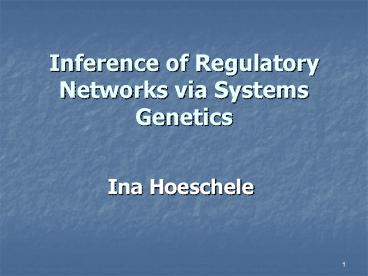Inference of Regulatory Networks via Systems Genetics - PowerPoint PPT Presentation
1 / 11
Title:
Inference of Regulatory Networks via Systems Genetics
Description:
Measure DNA sequence polymorphisms on a group of related ... Penalization ... Penalized Canonical Correlation Analysis (CCA) Represent CCA in ... – PowerPoint PPT presentation
Number of Views:25
Avg rating:3.0/5.0
Title: Inference of Regulatory Networks via Systems Genetics
1
Inference of Regulatory Networks via Systems
Genetics
- Ina Hoeschele
2
Systems Genetics
Infer cells regulatory structure
Infer molecular basis of phenotypes / diseases
Systems Biology
Complex Trait Biology
3
Systems Genetics
- Measure DNA sequence polymorphisms on a group of
related individuals (lt100 to 2000) covering the
entire genome (e.g. SNPs) - Several genotypes at each polymorphism (e.g. two,
0/1) - Multi-factorial perturbations of a system,
genetically randomized populations - Measure molecular and organismal variables, e.g.
- Expression profiling (etraits)
- Expression profiling and disease phenotypes
- Expression profiling, methylation profiling,
disease - Metabolite, protein profiling
4
Systems Genetics
- The genotypes at some polymorphisms influence
directly the expression of certain genes - in cis polymorphism A in gene As promoter
region influences its transcript abundance - in trans polymorphism A in gene As coding
region influences the function of protein A let
gene A be a regulator of gene B, then both
polymorphism A and gene A influence the
expression of gene B
5
Systems Genetics
- The genes expression profiles (etraits) have
both polymorphism and gene (etrait) regulators - Very large number of targets (regulated genes
etc.) - Very large number of potential regulators for
each target - Sample size (n) MUCH smaller than number of
potential regulators (p) - Targets are co-regulated
- Regulators are correlated
- Regulatory networks are cyclic
- Analyses of regulatory programs should account
for all of the above
6
Systems Genetics
- One target one regulator approach
- YT ? bPR e
- do for each T and each R (except cis analysis)
- low power
- trans YT ? b1YR b2PR e ( cisP)
- better power but does not account for
co-regulation of multiple targets
7
Systems Genetics
- One target all regulators approach
- YT ? ?Rb1RPR ( ?Rb2RYR ) e
- do for each T, still does not account for
co-regulation - standard variable selection methods and
regularization methods tend not to perform well
(nltltp, correlated regulators) - May also need to consider interactions among loci
- Often ignored or limited to two-way interactions
- Penalization/Regularization methods
- Constrained OLS, bounds on Lt norm(s) of
coefficients (t1, 2, ) - Elastic net variable selection (Zou and Hastie
2005) - Extension of lasso (compromise with ridge
regression) - nltltp, joint selection of correlated predictors
- Bayesian variable selection
- Priors on b
- MCMC ??
- Deterministic (e.g. variational) ??
8
Systems Genetics
- Clustering of targets
- Analyze jointly the targets in a cluster
- Single regulator model, multivariate analysis
costly - PCA within clusters, analyze PCs separately
- Analyze cluster with all regulator model
(individual Y model but joint variable selection)
- Geronemo iteratively perform clustering and
selection of clustermodule regulators
(regression tree) (Lee et al. 2006)
9
Systems Genetics
- Biclustering, two-group association
- Find groups of targets regulated by groups of
polymorphisms - Biclustering based on matrix of associations btw
targets and polymorphisms efficient but
meaningful results? - Various approaches for two-group association
- Penalized Canonical Correlation Analysis (CCA)
- Represent CCA in regression framework
- Bayesian CCA (probabilistic interpretation, joint
latent factor model for both groups of variables)
- MCMC (convergence issues, see factor analysis)
- deterministic (variational)
10
Systems Genetics
- Two-step regulatory network inference
- 1a) Construct an Undirected Dependency Graph
(UDG) using target data (e.g., expression) only - 1b) Determine which polymorphisms affects which
targets and use this information to direct edges
(e.g., Neto et al. 2008) - 2a) Perform cis and trans polymorphism analysis
and combine into an encompassing network (Liu et
al. 2008) - 2b) Sparsify the network, using structural
equation modeling SEM - extension of linear regression (variables can be
both response and predictor) - likelihoods for SEM and LR not the same for
cyclic networks - Toward one-step regulatory network inference
- Geronemo (etraits small list (300) of candidate
regulator genes)
11
(No Transcript)































